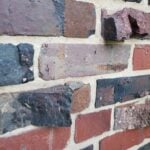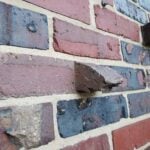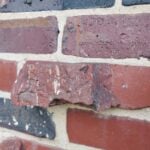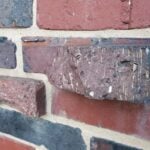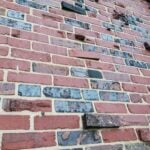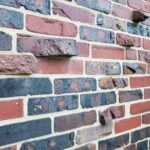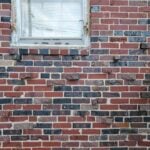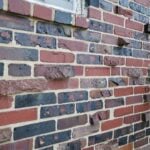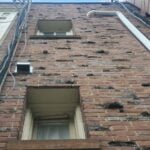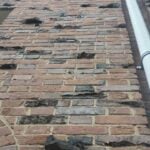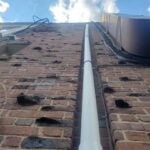Last week, we took a look at a mid-rise historic building facade as part of a case study to examine and understand historic masonry. This week, we’re taking a look at a really unique style of modern masonry which incorporates clinker bricks in a smaller scale but similar mid-century brick facade construction.
The picture below shows a northwest DC building built with a clinker brick style facade, a mid 20th century construction.
Before going into the details on clinker bricks, it’s A good idea to start by making some clarifications, up front, on the differences between how there’s between how we classify historic historic construction versus modern construction. A historic automobile may be as new as just 25 years old, in 2022. That would mean that a car made in 1997 would be considered historic. In the larger scale of time, that is very recent.
By comparison, buildings built in the mid 20th century are 70 years old yet still not considered historic. In many cases, those buildings are built with methodology similar to modern construction. And in this particular case, the styles that we are looking at now, in this week’s article were built around the 1940’s and although already almost 80 years old, we still consider them to be contemporary or modern construction because they are built with modern techniques. The materials used are also, even at that time 70-80+ years ago, created or manufactured with techniques that are similar to modern manufacturing technologies.
Most of the buildings in the Capitol Hill, Georgetown, and Dupont Circle neighborhoods of Washington DC were built with historic materials that have properties which are very distinct to modern materials. The historic common brick, for example, is a major building material in historic Washington, DC buildings. Modern bricks, in contrast, are very different, in several ways. A few examples of characteristics of contrast follow:
- Dimensions
- Vitreousness
- Permeability
- Durability
- Structural capacity
- Homogeneity
Back in August 2022 infinity design solutions took and solutions took a closer look at some of the distinguishing characteristics between historic bricks and modern bricks. A link to that article follows: Top 5 Ways To Tell if a Brick is Historic or Contemporary. In that article, we examined visually observable characteristics of brick masonry and showed how those characteristics and qualities, in detail, can indicate the age or era of a brick. Here, instead we are looking closer at the effect of those characteristics of distinction, to explain why it makes a difference in the performance and nature of the masonry, as it applies to clinker bricks.
Dimensions
- In previous articles we talked about differences of dimension between a historic brick vs.a modern brick. Historic bricks were simply larger and width in the stretch position. This dimension change was made nearly across-the-board in an effort to standardize brick size and make it the dimension easier for mathematical calculation. Historic masonry buildings require more complicated calculation to derive the quantity of brick units used innor needed for construction. For work such as tuck pointing and masonry restoration, the mathematical difference, and challenges in summation can be overcome with the use of a derived coefficient. Repointing work applies specifically to the mortar joints but the relation of brick mortar to brick unit is a factor in the pointing process.
Vitreousness
- Bricks are made from clay and consist of a few important molecules and elements that exist within every single brick in large proportions. The majority of a brick, by weight, is made-up of clay. Clay in turn is largely composed of silica, water, ammonia, and small amounts of carbon based organic materials. Water and organic materials largely burn off in the firing process. The materials that are then left, to some extent fuse together in a crystal structure. In extreme cases, at extremely high temperatures, those materials become highly vitreous, almost like glass. They have a lower density, relatively high compressive strength, but a relatively low tensile strength. This describes clinker bricks. They are comparatively highly vitreous, and as a result have a high resistance to permeability.
Permeability
- In the second paragraph above we talked about the difference in brick dimension, And we implied there was a difference in the ratio of brick to mortar between historic versus modern brick construction. Specifically with historic brick masonry, mortar joints were also generally wider than modern mortar joints. Although this detail technically falls into an issue or item under the category of dimensions or brick wall layout, the brick’s permeability also affects the wall’s ability to mitigate water entry. Generally, mortar joints are more permeable than the brick masonry units. This is not just a casual relationship, it’s intentional. Mortar joints are intentionally softer than brick or stone masonry units because the mortar itself can be easily restored and repointed without requiring the reconstruction of the entirety of the wall.
- If brick units are softer than the mortar, micro movements which are typical in nature, as buildings move with shifts and vibrations in subsoils, can cause bricks to crack and fail. If bricks throughout a building must be replaced, that then entails the reconstruction of the entirety of a wall or building which is extremely expensive. By comparison, while repointing is laborious, it’s much less expensive than the reconstruction of the building, so it simply makes pragmatic sense for the mortar to be the intentional sacrificial weak link in terms of permeability. By comparison, clinker bricks, in line with their highly vitreous nature, also have abnormally low permeability.Durability. Modern bricks, similar to the level of vitreousness, are also more durable than historic bricks. Before diving into understanding brick durability, it is important to think about this, not just in the context of the comparison of historic brick versus modern brick durability. It is also important to understand this difference in terms of mortar compatibility. Similar to permeability, it’s also important for historic brick mortar joints to be less hard and less dense than the brick masonry units themselves.
- This is extremely important when tuck pointing or restoring historic brick masonry. The density of the brick itself; therefore, is related to the density of the mortar. Here, in regards to durability, clinker bricks are also an anomaly. They have much higher compressive strength than a typical low temperature fired historic common brick, for example, but the analysis of durability doesn’t end at compressive strength. Other factors play into overall strength and durability. For example, similar to glass, clinker bricks have a very high compressive strength but very low tensile strength. You could say that in one critical area, clinker bricks are actually much weaker.
Structural capacity
- Since modern bricks are fired with modern fuel sources, they’re able to be fired at a much higher temperature than historic kilns. Historic kilns relied on organic materials for combustion such as hardwood. The original forests in early America were old-growth forests, never before cut or consumed by humankind. A virgin forest like this can also be referred to as a primary forest, late seral forest, primeval forest, or first-growth forest. The great forests of the east coast of the early American colonies were expansive, massive in scale and filled with massive trees. The timber harvested from historic times in America was an incredibly good fuel source. It is a devastating loss to America now that the virgin forest has largely been decimated, a true travesty. The timber wood of that time, although a terrific fuel source for combustion, was significantly less effective compared to modern natural gas and similar fuels. Wood fire simply could not reach the high temperature as gas fires at a continuous and consistent range. The consistent high temperature and controlled firing allows for greater structural capacity of modern bricks. Clinker bricks were still created in historic times, but only at the hottest parts of a kiln as historic kilns lacked consistent distribution of heat.
Homogeneity
- In historic times, modern electric or fuel driven equipment was unavailable. Animals, literally donkeys and horses, and humans working by hand, were used to process and filter the subcomponent materials used in brick mortar. Workers, in historic times, were very strong and horses and donkeys are also strong, but they’re nowhere near as strong as hydraulic, electric, or even steam powered equipment. Without this high power equipment, in historic times, It was very difficult to sift and sort the heavy substrate materials used in the manufacturing of bricks. Therefore, historic bricks, similar to historic lime mortar, are filled with a mixture of different materials. For example, chunks of lime in historic mortar can significantly range in size. In some cases there will be large chunks, up to and even over 1/2 of an inch in diameter. In other cases, aggregate will not just include small fine sand granules, but also include small pieces of rock, even small pebbles up two or even over 1/4 inch in diameter. By comparison, modern mortar has much higher consistency in the size of aggregate and the size of substrate materials in the mortar and bricks themselves.
All of this history and understanding of the technological advances is central to understanding the differences between the structural capacity of historic versus modern bricks.
In the image below, you can see an example of a historic brick with significant variation in the face of the brick, due to lack of homogeneity of the substrate materials.
Understanding the six criteria or characteristics above is useful to understand the physical characteristics and properties of clinker bricks. In some cases, the characteristics of clinker bricks stand in stark contrast to both traditional and contemporary brick masonry units.
Clinker bricks are from a time period that spans from historic to modern times but where used in architectural aesthetics two distinct periods:
- Late 19th century
- Mid 20th century
Clinker bricks were used for different purposes in these different time ranges. Where used in the late 19th century, they were often used for accent pieces adjacent to or interspersed with field details in the middle of partitions in walls.
By comparison, clinker bricks from the mid 20th century were used in specific architectural building styles such as certain Tudor style homes or buildings. In the pictures below you can see, similar to the picture at the top of the article, where clinker bricks have been interspersed into the field of a building facade. These randomized different pieces of broken bricks are used to create a sort of rustic aesthetic.
As bricks are fired to the intense temperatures, the clay becomes increasingly vitreous and substrate compounds of the clay fuse together in crystal formations, as detailed above in the description of the vitreous continuum, the effect of firing at the higher range of the temperature continuum creates a more vitreous brick.
The gallery below shows several examples of clinker bricks installed in the walls of mid-twentieth century buildings.
To properly maintain, repair, and care for these historic buildings, a knowledge, interest and understanding of historic building principles is required. Here in Washington DC, historic masonry buildings are extremely expensive and the amount of financial loss caused by improper repointing and low quality construction is staggering. However, in addition to the direct financial value of the property, there is also a cultural loss when historic buildings are damaged. By comparison, consider neighboring poor cities, when historic buildings are damaged, it’s not just the loss of value to the property owner, there’s also a loss to all inhabitants and visitors of a city, present and future, who care about architecture, history, and culture.
We encourage all of our clients, and all readers of this article and to our blog in general, to prioritize the historic built environment of Washington DC and neighborhoods such as Capitol Hill, Dupont Circle, and Georgetown and become educated on on the difference between proper historic preservation versus improper work which leads to significant damage to the historic fabric of a building.
From a conservation and preservation perspective, several approaches can be taken to improve conditions related to deteriorated historic brick masonry. Primarily, lime mortar brick joints and low temperature fired soft red clay bricks should be inspected and checked on a routine maintenance schedule, either seasonally or at least annually. If brick masonry is kept in good condition, the life of embedded wood elements can be significantly extended. Hire a professional contractor which specializes, understands and appreciates historic construction elements and buildings.
In this article we talked about the terminology and concepts of historic masonry restoration, follow the links below for more related information from the IDS website:
- Binders in mortars and concrete
- Butter joint
- Capillary action
- Cementitious siding
- Cheek wall, masonry — Draft
- Chemical testing
- Code, building — Draft
- Cold joint
- Cold weather masonry work — Draft
- Damp proof course
- Downspout
- Electrical distribution panel — Draft
- Fenestration
- Ferrous metals
- Great Chicago Fire
- Gutter, roof
- Lime mortar
- Lintel
- Oxidation
- Parapet coping
- Plug, clay
- Pressed bricks
- Raking, of mortar joints
- Raggle, aka reglet
- Rectilinear
- Roman bricks
- Roman arches
- Roof eave
- Roof termination
- Row buildings and row homes
-
- Rubbed bricks
- Rubble stone masonry
- Sand, Builder’s
- Sedimentary rock
- Scratch coat
- Sprung arch
-
- Squint bricks,
- Strike, or striking of mortar
- Tapestry bricks
- Tooth-in, interlocking masonry connections
- Vitreous
- Water diversion systems
- Zipper-joint
These concepts are part of the fundamentals of historic masonry restoration, tuckpointing, and brick repair.
The links in the list above will take you to other articles with more information on defects, failures, preservation and repair of historic masonry. You can learn a lot more on our blog. Feel free to check it out. If you have questions about the historic masonry of your building in Washington DC, fill out the webform below and drop us a line. We will be in touch if we can help.



